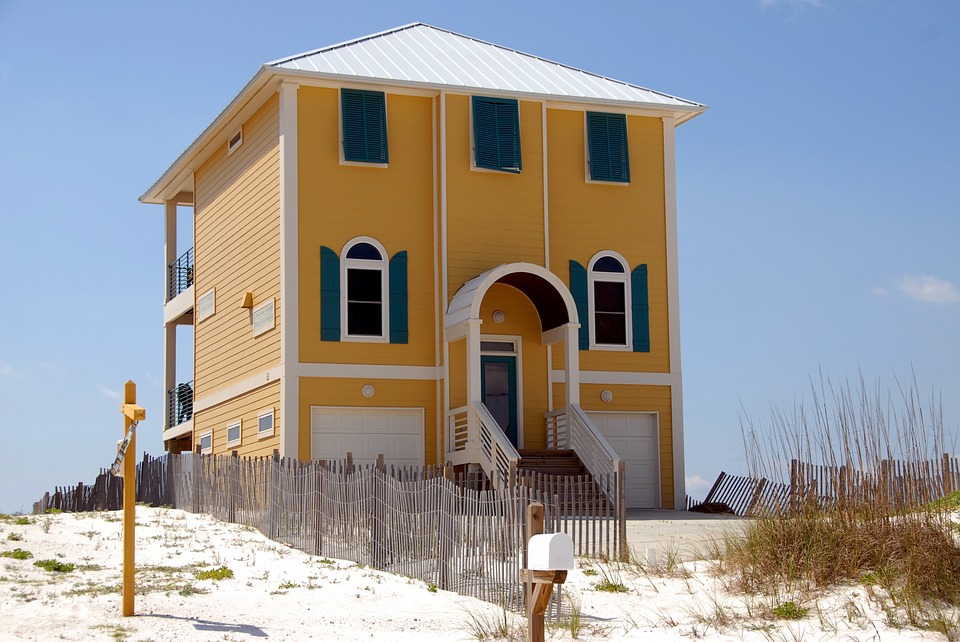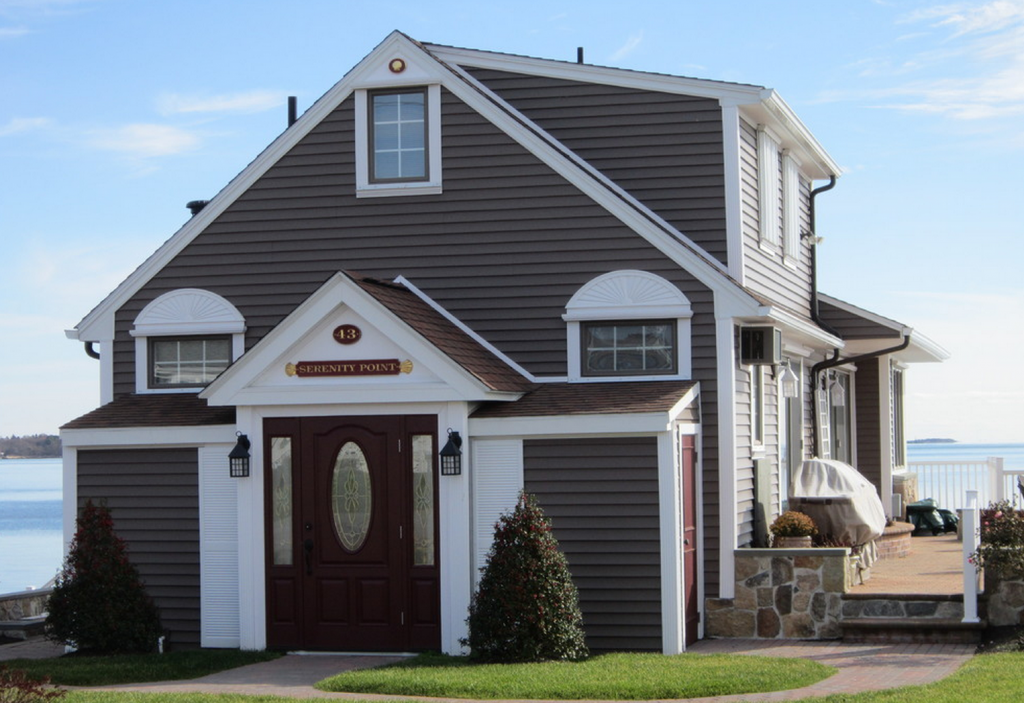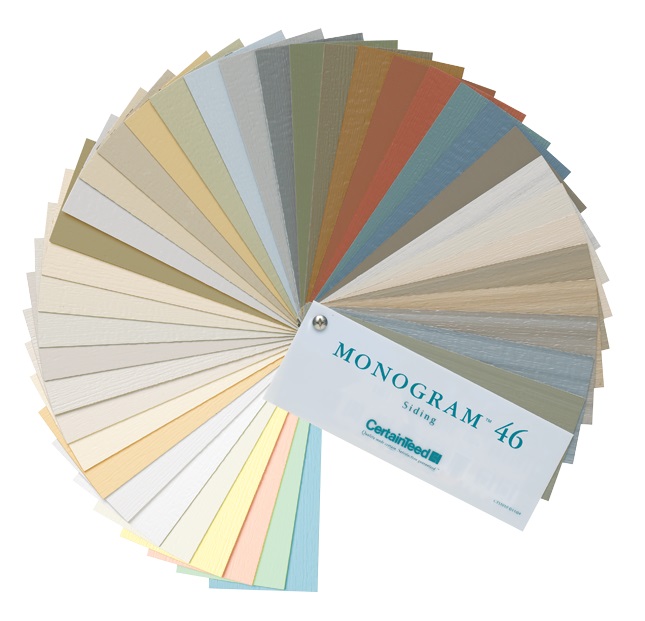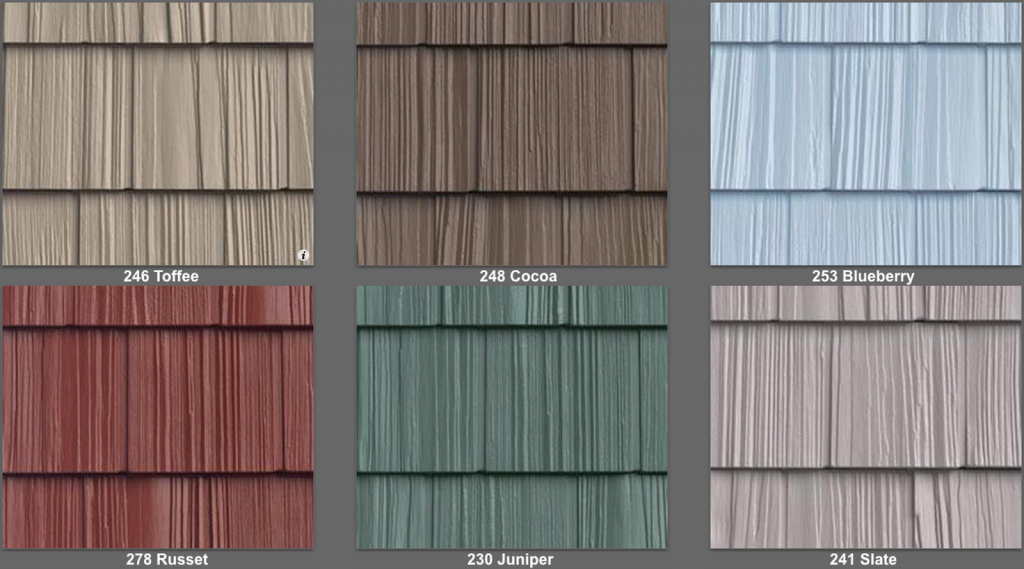PVC is widely understood as a heavy-duty plastic-based material. The “V” in the middle of the acronym stands for Vinyl, which in the home siding market, represents the #1 selling material for most of the US. The PVC used for siding benefits from additives that resist color fading and increase flexibility, while not sacrificing durability.
For residential siding, vinyl is quite versatile. The horizontal plank (bevel) style is the most common cladding option for vinyl, but there are many more ways it is utilized as a cladding material for homes and buildings. On the east coast, vinyl’s primary competition comes from wood and fiber cement, while stucco dominates the western part of the US.
Cost
Because R-Value is a key factor when considering any siding material, it is important to note that vinyl siding takes this into consideration and that this skews its pricing data.
Generally, costs for vinyl are based on material thickness, with most residential products ranging from .040 to .046 inches thick, or about 1/16th of an inch. At that level of thickness, the R-value is unsurprisingly low.
However, vinyl comes in one of two primary variations: hollow-back and insulated, or foam-back. The foam-back provides at least 3 times (or more) the R-value, while increasing the cost by at most 3 times, or usually doubling it.
In terms of what to expect pricing-vise, vinyl siding typically costs between $7.50 and $15.50 per sq. ft. installed. This breaks down to the low-end cost of $5.50 to $8.50 per sq. ft. for hollow-back (uninsulated) siding. Mid-range cost is $7.50 to $12.50 per sq. ft. for foam-back siding. The high-end or deluxe vinyl siding costs between $8.50 and $15.50 per square foot installed.
On average, hollow-back vinyl siding installation results in a $11,000 to $17,000 overall cost for a typical two-bedroom to three-bedroom sized house with approximately 2,000 sq.ft. of siding. Foam-back siding averages between $15,000 and $31,000 installed on a similar property om the US.
While “average” is a bit vague, we’ll break the costs down further (next section) and explain the factors that impact costs (2 sections below).
Pricing Info – Part 2
As noted above, when you select vinyl siding for your home, you are usually selecting thickness and whether it is insulated material or not. These aren’t your only options, but they contribute to the costs more than other options.
The style of siding is another key factor – whether panels are vertical or horizontal and whether they are shingle or shake type and/or split-log style. Often the nuances within a particular style type, along with contractor experience and product quality are the additional primary factors that impact costs.
To hopefully simplify things, let’s go with two examples of horizontal panels and what a job may entail to help you understand the pricing information more in depth:
Example project # 1
Hollow-back Vinyl Siding: 2,000 sq. ft. x $6.50 = $13,000 (includes primary materials, house-wrap, j-channels, supplies, and warrantied labor)
Color Matching Existing Exterior Features: (i.e. outlet covers, wall vents, etc.) = $500
Updated Window Trim: $3,000
(Optional) Detached Garage Update: (with all the above material considerations) x 700 sq.ft. = additional $3,000
Building Permit: $400
Total Project 1 Cost = $16,900 / $19,900
Example project # 2
Foam-back Vinyl Siding: 2,000 sq. ft. x $8.50 = $17,000 (Including all the materials and installation)
Removal of previous siding: $1,500
Garbage Rental / Disposal Charge: $900
Updated Window Trim: $3,000
(Optional) Detached Garage Update: (with all the above material considerations) x 700 sq. ft = additional $4,000
Building Permit: $400
Total Project 2 Cost = $19,800 / $25,800
Factors Impacting Installation Costs
In our examples above, you’ll see the same size house (and detached garage) with similar charges and variation or options for additional charges. Let’s review those and other factors that impact costs.
The primary factor would be the size and layout of a house where vinyl siding will be installed. This difficulty of the overall installation based on the layout and other variables including custom trim requirements, can greatly impact costs. The amount of labor based on the overall project difficulty is what a contractor will be basing most of their labor costs on.
Normally, most residential homes have surface areas that are easily accessible, rectangular and match the experience of previous jobs. However, often enough, each house will have its own unique nooks and crannies such as multiple gables at two story-heights that are more challenging and time consuming due to a triangular shape of the gable, for example.
Thus, a more difficult and less accessible job with custom trim requirements, will impact labor costs and the amount of time necessary to complete the project for the contractor. — Usually, the impact of difficult areas and custom trim is not dramatic, but any area that is more difficult and less accessible, means the pacing of the overall job must be adjusted for the unique layouts and/or custom trim requirements.
The exact type of vinyl siding is the next significant cost factor. On average, foam-back profile doubles the cost of vinyl siding. Yet, this is not always the case. Higher quality siding with thicker insulation backing will go over the high-end average of $10.50 per sq. ft. and probably come in around $12.50 per sq. ft. installed.
The profile or how panels, or planks, are laid out exactly is one factor, thickness of the vinyl siding is another factor, the texture of the surface is yet another factor. The thickness can go up to .052, which is uncommon but is sold through the vinyl siding suppliers and is of course the most expensive option.
Labor costs are normally fairly standard to a region, but can vary by experience, amount of crew members on site, and whether the crew is part of a large high-end remodeling company and/or is installing a specific brand that carries additional warranties and such.
Installing vinyl siding is generally not complex, and is a job a handy person could accomplish, though likely much less efficiently or with less care around window trim details due to lack of experience and/or not having the right tools such as break. Two story homes with gable roofs may pose the greatest challenges for a less-experienced installer.
Waste of materials is generally accounted for by professional contractors and kept at a minimum, whereas the inexperienced installer is probably not accounting for this in their estimate and may way underestimate how much that will ultimately be.
Replacing or updating certain house features such as soffits and window trim is often a strong consideration when doing a siding job. When getting siding job estimates, the price for these updates will normally be itemized separately.
As a homeowner, make sure you ask whether it’s included and ask any questions you may have about what such updates will mean for you and your home.
In general, if your home’s old exterior is showing wear and tear, chances are the window trims do as well. So, keeping that on a newly sided home will have the trim stick out like a sore thumb.
Likewise, in our example is the detached garage optional cost. If your house has no buildings apart from the home and/or your garage is attached, then this doesn’t apply as the siding cost at top of the list would account for all square footage of installation. But keep in mind, if there is such a structure, it too may be getting all the materials (minus house wrap perhaps) that go into overall project cost.
Removal of existing siding is sometimes options but usually a cost factor that needs to be considered. The removal charges plus disposal can add up but is likely far better done by professional contractor who has the ability to do this quickly and with care that a non-contractor does not. Clean-up alone from such a task is worth it.
Colors
Incidentally, color adds zero to the cost and contractors will be able to offer really any color you can imagine but typically have 7 to 35 color options to select from. If you go outside of those there may be additional charge for custom ordering.
The rest of the items are necessary parts of the job, but low on cost. It’s hard to have a contractor put siding on your house without a building permit, or nails and the additional construction materials. — All of these added together amount to under 50 cents per sq. ft., but an item such as building permit isn’t based on square feet as much as it is your local municipality.
The Good, The Bad and The Oh So Pretty
The Good: Vinyl Siding is a budget friendly way to achieve durable, long lasting color on your home. Colors fade evenly and the material holds up well in weather and against insects. The ROI factor is good (at about 77% of value you put in).
The Bad: Because of the association with plastic, vinyl siding may not be to your liking, though it’s really challenging to tell the difference between vinyl siding and say fiber cement or wood from the curbside. There’s also a concern that vinyl melts or warps when exposed to extreme heat, i.e. too much sun. This can and does happen but is very rare.
The Oh So Pretty: Going with foam-backed vinyl siding provides top notch R-Value in terms of residential home cladding. Only natural stone, which is the most expensive siding option rivals it.
Is Vinyl Siding a Viable Option for Homes?
Yes, vinyl siding can be a viable option for homes. It offers several benefits, including its affordability, low maintenance requirements, and durability. However, there are some factors to consider when deciding whether vinyl siding is right for your home.
Firstly, vinyl siding may not have the same aesthetic appeal as natural wood, engineered wood, fiber cement, or other materials. However, it comes in a variety of colors and styles, so homeowners can still achieve a desired look.
Secondly, while vinyl siding is durable and long-lasting, although, it can become brittle and crack in extreme weather conditions, such as hail or high winds. It is important to choose a high-quality vinyl siding product and ensure proper installation to minimize the risk of damage.
Lastly, vinyl siding can be susceptible to fading or discoloration over time, especially if exposed to prolonged sunlight. However, newer vinyl products are often formulated to resist fading and discoloration.
Overall, vinyl siding can be a good option for homeowners who value its affordability, low maintenance requirements, and durability. However, it may not be the best choice for homeowners seeking a specific aesthetic look and feel or for those in areas prone to extreme weather.
Pro Tip: In hurricane prone areas, use high-wind rated siding with double nailing hems. Thicker gauge vinyl panels offer better wind resistance during severe weather.
According to FEMA, thick, rigid panels provide greater wind resistance, withstand dents, and lie flatter and straighter against the wall. Optimum panel thickness should be 0.040 to 0.048″, depending on style and design.
Thinner gauge vinyl works well for stable climates; thicker gauge vinyl is recommended for areas with high winds and high temperature changes.
FAQs
- What is vinyl siding made of? Vinyl siding is made of polyvinyl chloride (PVC) resin, combined with additives such as pigments, stabilizers, and impact modifiers.
- How long does vinyl siding typically last? Vinyl siding can last for several decades with proper installation and maintenance. It is generally expected to last at least 20-30 years.
- Is vinyl siding resistant to weather damage? Vinyl siding is generally resistant to weather damage such as moisture, rot, and insects. However, it can become brittle and crack in extreme weather conditions such as hail or high winds.
- Does vinyl siding require maintenance? Vinyl siding requires minimal maintenance, such as periodic cleaning to remove dirt and debris. It does not require painting or staining like natural wood siding.
- Can vinyl siding be painted? While vinyl siding can be painted, it is generally not recommended. Painting can void the manufacturer’s warranty and may not adhere properly to the vinyl surface.
- Can vinyl siding be recycled? Some vinyl siding products are recyclable, but not all recycling facilities accept it. Homeowners should check with their local recycling center to see if they accept vinyl siding.
- Is vinyl siding energy-efficient? Vinyl siding can be energy-efficient if properly installed with insulation and an air barrier. Insulated vinyl siding can help reduce heat loss and improve energy efficiency in a home.
- Can vinyl siding be installed over existing siding? In some cases, vinyl siding can be installed over existing siding. However, this may not be recommended or possible in all situations, depending on the condition and type of existing siding.




“The good, the bad, and the oh so pretty” that’s funny 😀 Good article